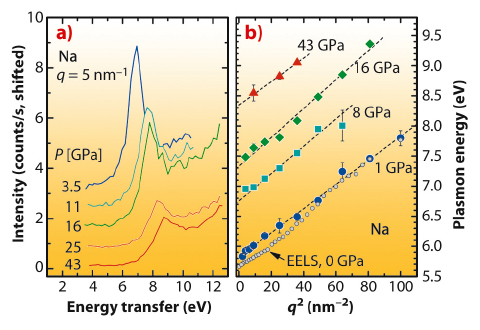- Home
- Users & Science
- Scientific Documentation
- ESRF Highlights
- ESRF Highlights 2011
- Dynamics and extreme conditions
- Plasmons in sodium under pressure
Plasmons in sodium under pressure
“Simple” or nearly free-electron (NFE) metals are characterised by a weak interaction between the conduction electrons and the atomic cores (the electron-ion interaction), and they crystallise in high-symmetry densely-packed crystal structures such as body-centred-cubic (bcc). At ambient conditions, sodium is one of nature’s best manifestations of a simple metal, but its properties change fundamentally at high compression. In the megabar pressure range, a series of phase transitions into lower-symmetry crystal structures has been observed, accompanied by marked changes in its optical properties and culminating in the formation of a nonmetallic, visually transparent phase at ~200 GPa.
A central question is how the transformation from a simple metal to a semiconductor progresses, i.e., does the non-NFE behaviour of sodium start only with the transitions into the lower-symmetry phases above 105 GPa, or are there significant precursors in the bcc and face-centred cubic (fcc) phases at lower pressure? To provide an answer, we have used inelastic X-ray scattering (IXS) on beamline ID16 to measure plasmon energies and dispersion relations of sodium at high pressure, up to 43 GPa. Plasmons are collective electronic excitations – longitudinal charge density waves with finite wave vectors – and they determine the optical response of a metal. As the plasmon energies of an electron gas scale with its density, high-pressure experiments are an excellent tool to tune and study plasmon properties. Electron energy-loss spectroscopy (EELS) has long been used to measure plasmons, but this technique is not suitable for samples enclosed in high-pressure cells, and we have therefore used IXS.
Figure 8a shows typical IXS spectra of sodium that was compressed in diamond anvil high-pressure cells. For a given momentum transfer q, the single plasmon peak of sodium shifts towards higher energies as the pressure is increased. Figure 8b shows a summary of the experimental plasmon dispersion relations.
 |
|
Fig. 8: a) IXS spectra of polycrystalline sodium at pressures up to 43 GPa and a fixed momentum transfer of q = 5 nm-1. b) Plasmon energies of sodium as a function of momentum and pressure. |
The theoretical description of plasmons in simple metals is well established. The most commonly used approach starts from the free-electron (FE) gas and uses the random phase approximation (RPA). It yields a simple quadratic relation for the plasmon energy dispersion,
![]()
where ωp is the plasma frequency, a the dispersion coefficient and m the electron mass. Both the plasma frequency and the dispersion coefficient scale with the electron density n ( ωp ![]() n1/2, α
n1/2, α ![]() n1/2
n1/2![]() n1/6), and in sodium we increased the electron density up to 2.6-fold relative to normal density. Refined versions of this simple FE/RPA model include the polarisability of the atomic cores (FE/RPA+core polarisation model) and use a better description of the electronic band structure (“PG model” after Paasch and Grigoryan).
n1/6), and in sodium we increased the electron density up to 2.6-fold relative to normal density. Refined versions of this simple FE/RPA model include the polarisability of the atomic cores (FE/RPA+core polarisation model) and use a better description of the electronic band structure (“PG model” after Paasch and Grigoryan).
The results shown in Figure 8b are in qualitative agreement with the predictions for a free-electron gas: the dispersions show the expected q2 dependence, and the plasmon energies increase with increasing density. Quantitatively, however, there are striking discrepancies as illustrated in Figure 9 for the q = 5 nm-1 plasmon. If the core polarisation is taken into account, the FE/RPA model yields a good description at low pressure, but at high pressure, both FE/RPA models significantly overestimate the plasma frequency as well as the plasmon dispersion coefficient, and consequently the plasmon energies. While the PG model is on equal footing with the FE/RPA+core polarisation model, it uses a more accurate description of the shape of the conduction band, which we determined in ab initio electronic structure calculations. The PG model, which does not have any adjustable parameters, yields plasmon energies in excellent agreement with the IXS results.
 |
|
Fig. 9: Pressure dependence of the q = 5 nm-1 plasmon of sodium as measured by IXS (symbols), and comparison with three different models (lines). |
The observed deviation from NFE behaviour can in part be attributed to the polarisability of the ionic cores, but to a larger extent it is caused by pressure-induced changes in the electronic band structure. These, in turn, originate from the electron-ion interaction in sodium becoming stronger with increasing pressure. In other words, the behaviour of sodium departs increasingly from that of a NFE gas, and this can be seen as a precursor of the fundamental changes at megabar pressures.
Deviations from NFE behaviour have been observed before for other metals (at zero pressure), but, with few exceptions, they were attributed to electron exchange and correlations effects, and a number of extensions of the RPA were proposed in this spirit. As exchange and correlation effects decrease with increasing density, they can be excluded as the origin of the deviations we observed for sodium. In a constant-pressure experiment, this balance between band structure and exchange-correlation effects is more difficult to assess, and our present results indicate that band structure effects may be more important for the plasmon properties of metals than previously thought.
Principal publication and authors
I. Loa (a,b), K. Syassen (a), G. Monaco (c), G. Vankó (c,d), M. Krisch (c) and M. Hanfland (c), Phys. Rev. Lett. 107, 086402 (2011).
(a) Max-Planck-Institut für Festkörperforschung, Stuttgart (Germany)
(b) Present address: The University of Edinburgh (UK)
(c) ESRF
(d) Present address: KFKI Research Institute for Particle and Nuclear Physics, Budapest (Hungary)



